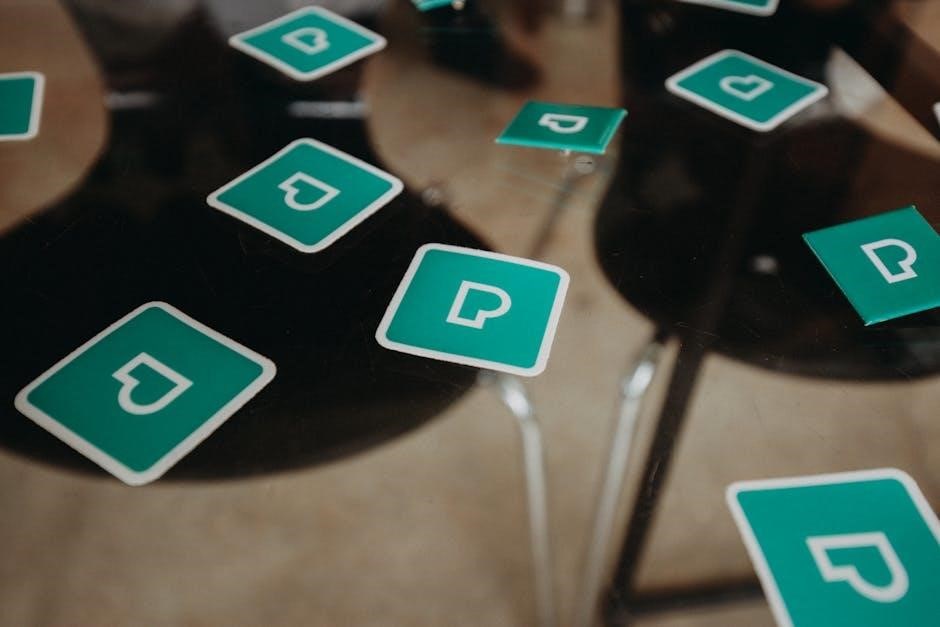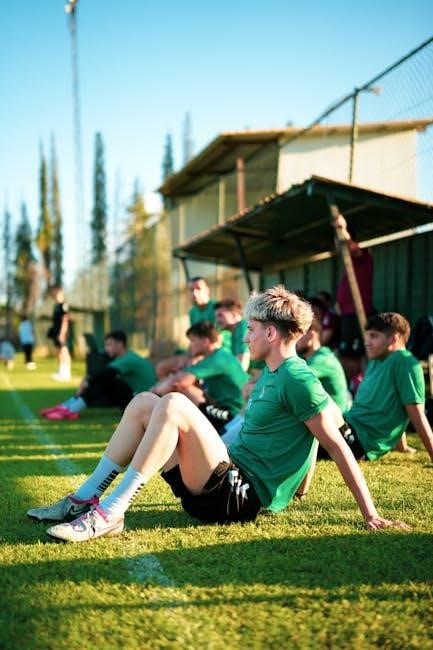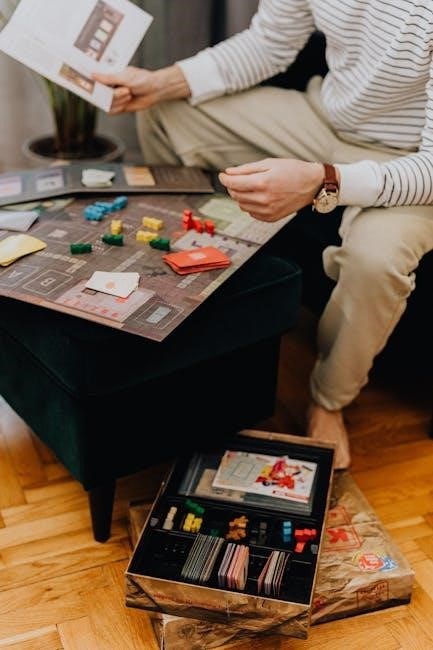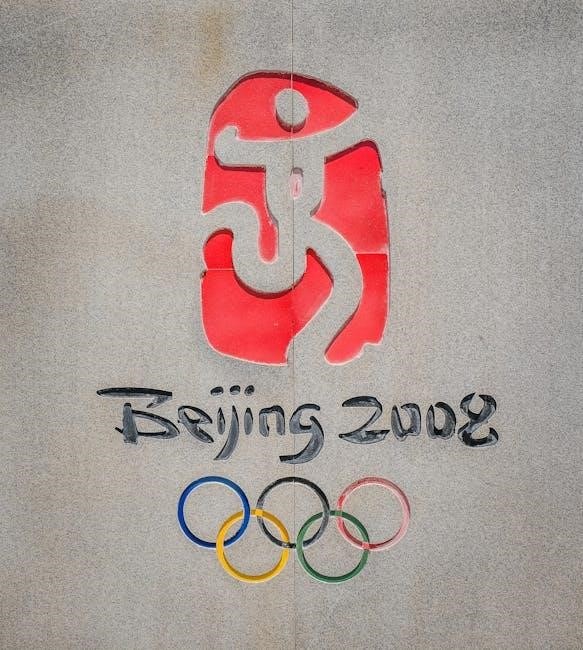The Logo Game is a fun, interactive activity where players identify famous logos, fostering brand awareness and quick thinking in a competitive or casual setting.

1.1 What is the Logo Game?
The Logo Game is an interactive and engaging activity where participants identify and recognize famous logos from various brands, companies, and organizations. It involves visual recognition, brand awareness, and quick thinking. Players are typically shown logo images, either with or without text, and must correctly name the brand associated with the logo. The game can be played individually or in teams, making it a versatile activity for different settings. It’s designed to test knowledge of popular brands while fostering fun and competition. The simplicity of the concept makes it accessible to a wide range of ages and backgrounds.
1.2 Why Play the Logo Game?
The Logo Game is a fun and educational activity that enhances brand awareness, memory, and cognitive skills. It fosters quick thinking and sharpens recognition abilities, making it both entertaining and intellectually stimulating. Players of all ages can enjoy it, as it taps into their knowledge of popular brands and logos. The game encourages teamwork when played in groups and can spark friendly competition. It’s also a great way to learn about different industries and their branding strategies; Whether for casual fun or as a learning tool, the Logo Game offers an engaging experience for everyone involved.

Objective of the Game
The objective is to correctly identify famous logos, earning points for accurate answers. Players aim to recognize both well-known and lesser-known brands quickly and accurately to win.
2.1 Understanding the Goal
The goal of the Logo Game is to correctly identify and name brands based on their logos. Players must recognize both iconic and obscure logos quickly. The game tests brand awareness, memory, and quick thinking. In team play, collaboration is key to achieving the goal. The objective is straightforward: name the brand before time runs out, if a timer is used. The goal encourages competitive spirit while fostering knowledge of global and local brands. Accuracy and speed are essential to succeed. Understanding the goal helps players focus on the core mechanic of the game, making it both challenging and enjoyable.
2.2 What Makes the Logo Game Challenging?
The Logo Game’s challenge lies in its demand for quick recognition and accurate recall of logos. Players must think rapidly, especially under time constraints. Obscure or less familiar logos can stump even knowledgeable participants. Variations in logo designs, such as outdated or international versions, add complexity. Additionally, some logos may resemble others, requiring sharp memory to distinguish. The pressure to answer correctly before time expires or opponents do can heighten the difficulty. These elements combine to create a engaging yet demanding experience that tests both brand knowledge and mental agility.

Materials Required
The Logo Game requires logo cards or printed images, pens, and paper for writing answers. A timer is optional for adding a time challenge, enhancing excitement.
3.1 Logo Cards or Images
Logo cards or images are the core of the game. These can be printed from the internet or sourced from existing materials. Ensure the logos are clear and recognizable. Use a variety of brands, including well-known and lesser-known ones, to cater to different knowledge levels. High-quality images will make the game more enjoyable. Consider laminating the cards for durability. You can also include logos from different industries to add diversity. Regularly update the logos to keep the game fresh and challenging for repeat players. This ensures the game remains engaging and fun over time.
3.2 Pens and Paper
Pens and paper are essential for players to write down their answers. Provide sharp, dark-ink pens for clarity. Use plain or lined paper, depending on preference. Ensure each player or team has their own set to avoid delays. Extra pens and paper should be available in case of shortages. Consider using colored pens for teams to differentiate answers easily. Make sure the paper is large enough for legible writing. Organizing the materials beforehand ensures smooth gameplay. These simple tools are crucial for capturing answers accurately and efficiently during the game.
3.3 Timer (Optional)
A timer adds excitement and challenge to the game by limiting the time players have to answer. Set it for 30 seconds to one minute, depending on the difficulty level desired; This tool keeps the game dynamic and prevents prolonged delays. Players must provide their answers before the timer runs out, or the next player gets a chance to respond. Using a timer adds a strategic element, as participants must balance speed and accuracy. It also ensures the game progresses at a steady pace, keeping everyone engaged and focused. A timer is a simple yet effective way to enhance gameplay.
3.4 Additional Materials for Variations
To enhance the game, consider adding materials like blank logo cards for player-created challenges or themed rounds (e.g., sports, tech, or food brands). Introduce buzzers for speed rounds or a whiteboard for drawing logos when verbal descriptions are tricky. Audio clips of brand jingles can add a musical twist, testing players’ ability to recognize sounds. Custom scoreboards or token rewards can incentivize participation. These additions allow you to tailor the game to different preferences and keep it fresh for repeat players. They also make the game more dynamic and adaptable to various group sizes or ages.

Setting Up the Game
Setting up the Logo Game involves organizing materials, dividing players into teams, and preparing the play area. Ensure clear rules and a fair setup for an engaging experience.
4.1 Preparing the Logo Cards
Preparing logo cards involves gathering high-quality images of well-known brands. Print or display them clearly on cards or screens. Ensure the logos are recognizable and free from clutter. Use a mix of global and local brands to cater to diverse knowledge. For durability, laminate the cards or use digital versions. Organize them alphabetically or by category for easy access. Include a few lesser-known logos to add challenge. Verify that all logos are up-to-date and accurately represent the brands. This step ensures the game is both fun and educational, testing players’ brand recognition skills effectively.
4.2 Dividing Players into Teams
Divide players into teams of 2-5 members to encourage collaboration and healthy competition. Teams can be formed randomly or based on preferences. Ensure teams are balanced in size and skill level for fairness. Larger groups can have more teams to keep the game dynamic. Assign team names or colors for easy identification. Encourage teamwork by allowing players to discuss logo guesses within their group. This setup promotes social interaction and strategic thinking. Make sure all players understand their team assignments before starting the game to maintain smooth gameplay and equal participation opportunities.
4.3 Setting Up the Play Area
Arrange the play area to ensure all players can see the logos clearly. Seats should be positioned to face the logo presentation area. Place pens, paper, and scoring materials within easy reach of each team. Designate a central space for displaying logo cards or images. Ensure good lighting and minimal distractions. A scoreboard or whiteboard can be used to track points. Organize the logo cards in a visible and accessible location. Make sure the play area is spacious enough for teams to collaborate comfortably. This setup creates an engaging and organized environment for the game.
4.4 Explaining the Rules
Clearly outline the rules to ensure all players understand the game mechanics. Explain that players must identify logos accurately to earn points. Emphasize that only one guess per logo is allowed. Detail the scoring system, such as awarding points for correct answers and penalizing incorrect ones. Highlight the time limit for responses and the consequences of exceeding it. Stress the importance of teamwork and fair play. Make sure everyone knows how the game progresses and when it ends. This ensures a smooth and enjoyable experience for all participants. Proper rule explanation sets the foundation for a fun and competitive game.

Gameplay Instructions
The Logo Game involves recognizing and naming famous logos. Players earn points for correct answers, with each round offering a new challenge. It’s a fun, engaging way to sharpen brand recognition while fostering friendly competition. The game is easy to learn but challenging to master, making it enjoyable for all ages. Proper gameplay ensures everyone has a great time while exercising their memory and attention to detail.
5.1 Starting the Game
To begin, ensure all players understand the rules and their roles. The game moderator starts by presenting the first logo, either physically or digitally. Players signal their readiness to guess, often by raising hands or buzzing in. The moderator calls on a player to answer, and the timer starts if being used. Correct answers earn points, while incorrect ones may result in penalties. The game proceeds in rounds, with turns rotating among players or teams. Clear communication and adherence to rules are key to a smooth start and enjoyable experience for everyone involved.
5.2 Presenting the Logos
Logos are displayed one at a time, either physically, digitally, or both. The moderator ensures each logo is clearly visible to all players. For fairness, logos should be of similar size and quality. If using digital formats, ensure all devices are synchronized. Players should not have prior access to the logos to maintain challenge integrity. The moderator may add suspense by gradually revealing details or using animations. Presentation style can vary based on the game’s difficulty level or theme, keeping the game engaging and unpredictable for participants.
5.3 Guessing the Logo
Players take turns to guess the logo by stating the brand name aloud. Teams or individuals can participate, and guesses are typically made in a shout-out format. The moderator verifies the correctness of the answer. Multiple guesses are allowed until the correct one is given. Players can collaborate or compete, depending on the game mode. The faster a player responds, the higher the chance of earning points. Incorrect guesses are noted, and the next player or team gets an opportunity to answer. The goal is to identify as many logos as possible within the allotted time.
5.4 Scoring Points
Each correct guess earns the player or team 1 point. Bonus points can be awarded for rapid responses or particularly challenging logos. Points are tallied on a scoreboard. Incorrect guesses result in no points, but penalties for repeated wrong answers may apply. The scoring system encourages accuracy and speed, with optional time-based bonuses for faster responses. Players can also lose points for incorrect answers, adding an extra layer of strategy. The goal is to accumulate the highest score by the end of the game. Points are tracked and updated after each round to maintain clarity and fairness.
5.5 Time Limits for Answers
To maintain pace and challenge, a time limit is set for each player’s response. Typically, players have 10–30 seconds to identify a logo. The timer begins once the logo is revealed. If the player exceeds the time limit, their turn ends, and the next player or team attempts the logo. Time limits can be adjusted based on the game’s difficulty level or player preferences. Optional variations include speeding up the timer for advanced rounds or penalizing delays. This feature ensures the game remains engaging and fast-paced, keeping all participants focused and active throughout the session.
5.6 Handling Incorrect Answers
If a player provides an incorrect answer, their turn ends immediately. The next player or team is given the opportunity to identify the logo. In some variations, a small penalty, such as losing a point, may be applied for incorrect guesses. The game continues until a player correctly identifies the logo. Incorrect answers are noted to avoid repetition and to provide feedback for players to improve; Optional variations include allowing a brief explanation before moving on or penalizing repeated wrong answers to encourage accuracy and strategic thinking among participants. This system keeps the game fair and engaging for everyone involved.
Winning the Game
Winning the game is achieved by reaching the target score first or having the highest score at the end of all rounds. Celebrating the winner wraps up the competition on a positive note.
6.1 Reaching the Target Score
Reaching the target score is the primary objective in the Logo Game. Points are accumulated by correctly identifying logos, with the target set at the start. The first to reach this score wins, emphasizing quick thinking. The game ends once the target is met, determining the winner. A celebration often follows, marking the achievement and concluding the game on a high note.
6.2 Celebrating the Winner
Celebrating the winner is an exciting part of the Logo Game. Once a player or team reaches the target score, the game concludes with applause and recognition. The winner can be awarded a small trophy, prize, or verbal commendation. This moment fosters a sense of achievement and camaraderie. Celebrating the winner adds to the fun and creates memorable experiences. It also motivates players to improve their skills for future games. The celebration marks the end of the competition, leaving everyone with a positive and enjoyable experience.

Bonus Challenges
Bonus challenges add excitement to the game by introducing unique twists and testing additional skills, enhancing engagement and fun for all participants.
7.1 Speed Rounds
Speed rounds add an adrenaline rush to the game by setting a strict time limit for logo identification. Players must quickly recognize and name logos within a set timeframe, typically 30 seconds to a minute. This bonus challenge tests not only logo knowledge but also reflexes and calmness under pressure. Teams or individuals with the fastest correct answers earn extra points. Speed rounds can be interspersed throughout the game to keep players on their toes and add an exciting competitive edge. They are an excellent way to boost engagement and make the game more dynamic.
7.2 Theme-Based Rounds
Theme-based rounds introduce a unique twist by grouping logos into specific categories, such as technology, food, or automotive brands. This allows players to focus their knowledge on a particular area, enhancing engagement and strategy. Teams can prepare in advance or specialize in certain themes for an advantage. The themed approach adds variety to the game, making it more structured and enjoyable. It also caters to players with expertise in specific industries, leveling the playing field and encouraging diverse participation. Theme-based rounds are a great way to keep the game fresh and exciting for repeat players.
7.3 Penalty for Repeats
Implementing a penalty for repeated logos ensures the game remains dynamic and challenging. If a logo has already been used in previous rounds, teams that repeat it lose points. This rule prevents players from relying on the same logos and encourages creative thinking. A designated tracker or list can be used to monitor used logos. For example, a team might lose five points for each repeated logo. This adds a strategic layer, as players must balance quick thinking with avoiding penalties. The penalty system keeps the game fresh and pushes players to think beyond the most obvious choices.

Customizing the Game
Customizing the Logo Game allows you to tailor it to your audience, making it more engaging and personalized. Adjust difficulty, add unique themes, or incorporate storytelling elements to enhance fun and creativity for players of all ages and skill levels.
8.1 Creating Your Own Logo Cards
Creating your own logo cards allows for personalized gameplay. Gather high-quality logo images, ensuring they are clear and recognizable. Print them on sturdy cardstock or paper, and consider laminating for durability. Organize the logos into categories, such as industries or regions, to add variety. Include a mix of well-known and lesser-known brands to cater to different skill levels. Finally, test the cards before the game to ensure they are legible and free of repetition. This customization ensures the game is tailored to your audience, making it more engaging and enjoyable for everyone involved.
8.2 Adjusting Difficulty Levels
To make the game more accessible or challenging, adjust the difficulty by selecting logos of varying recognition levels. For easier rounds, use well-known brands like Coca-Cola or Apple. For harder levels, include obscure or less common logos, such as regional brands or niche products. You can also modify the game by adding time limits or penalizing incorrect guesses. Including logos with similar designs or historical versions can further test players’ knowledge. This flexibility ensures the game remains engaging for both casual and experienced participants, keeping everyone entertained and challenged according to their skill levels.
8.3 Adding a Storytelling Element
Add a creative twist by incorporating storytelling into the game. Before presenting a logo, provide a brief narrative about its origins, evolution, or cultural impact. For example, share how McDonald’s Golden Arches became a global symbol or the story behind Nike’s “Just Do It” slogan. This adds depth and engagement, turning the game into a learning experience. Players can also create their own stories about fictional logos, fostering creativity. This element makes the game more dynamic and enjoyable, appealing to both competitive players and those who appreciate a more immersive experience.

Tips for Success
Sharpen your observation skills, memorize logo details, and collaborate with teammates to maximize scores. Practice identifying lesser-known brands and manage time wisely to answer quickly and accurately.
9.1 Recognizing Logo Styles
Recognizing logo styles involves identifying key design elements like colors, shapes, and typography. Many logos use simplicity, symmetry, or iconic symbols to create brand recognition. Pay attention to common patterns, such as flat designs, minimalist approaches, or vintage styles. For example, tech brands often use clean lines and modern fonts, while food brands may incorporate bright colors or food-related imagery. Studying famous logos and their evolutions can improve your ability to recognize styles quickly. This skill enhances your gameplay by helping you identify logos based on their visual cues, even if the name isn’t immediately clear.
9.2 Collaborating with Teammates
Collaborating with teammates is crucial for success in the Logo Game. Encourage open communication and share thoughts about the logos shown. Team members can bounce ideas off one another, combining knowledge to identify tricky logos. Assign roles, such as a spokesperson for answers or a timekeeper, to streamline decision-making. Pooling collective knowledge enhances accuracy and speed, especially when recognizing less familiar brands. Effective teamwork fosters a fun, competitive atmosphere and increases the chances of winning. Ensure everyone’s input is valued to maximize your team’s performance and enjoyment of the game.
9.3 Managing Time Effectively
Managing time effectively is essential to maximize your score in the Logo Game. Assign a team member as a timekeeper to ensure quick responses during rounds. Encourage players to think aloud and share ideas rapidly, focusing on the most recognizable logos first. Avoid overthinking, as hesitation can cost valuable seconds. Practice under timed conditions to improve speed and accuracy. Stay focused and prioritize clarity in communication to make the most of the time allotted. Effective time management enhances teamwork and increases your chances of winning the game.
The Logo Game concludes with a fun, engaging experience that sharpens brand recognition and strategic thinking. Players leave with new knowledge and excitement for future rounds.
10.1 Wrapping Up the Game
Once all rounds are complete, tally the final scores to declare the winner. Reflect on the game by discussing standout moments and shared laughter. Ensure all materials are neatly organized for future use. Thank participants for their involvement and congratulate the champion. Encourage players to share their favorite parts of the game and any memorable logo challenges. Finally, bid farewell to everyone, leaving them with a positive and entertaining experience. This closure ensures a satisfying end to the Logo Game, keeping everyone engaged until the very last moment.
10.2 Discussing the Experience
After the game concludes, take a moment to discuss the experience with all participants. Reflect on standout moments, such as tricky logos or surprising correct answers. Encourage players to share their favorite parts of the game and any challenges they faced. This discussion fosters camaraderie and provides insight into what worked well and what could be improved. Highlight the fun and competitive aspects, celebrating the excitement of identifying logos. Use this opportunity to gather feedback and suggestions for future games, ensuring everyone leaves with a positive and memorable experience.
10.3 Planning Future Games
After wrapping up the current game, consider planning future sessions to keep the excitement alive. Gather feedback from players to understand what they enjoyed and what could be improved. Discuss potential themes, such as focusing on specific industries or introducing timed challenges. Encourage participants to contribute by creating new logo cards or suggesting rules variations. Having a plan in place ensures future games are fresh and engaging, keeping everyone eager to play again. This proactive approach not only maintains interest but also allows for continuous learning and fun in a dynamic setting.
